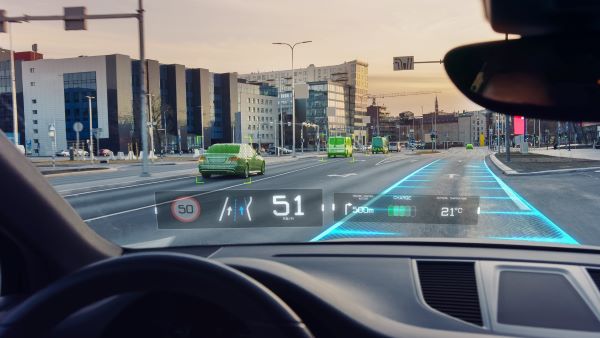Bottom-emitting Transparent Organic Light-Emitting-Diodes (TOLEDs) allow for one-sided display of information on transparent screens, while enabling clear visibility of individuals on both sides of the glass.
So how are bottom emitting TOLEDs helping to reshape privacy and connectivity?
Branching out from the traditional OLED – we have the TOLED. They are relied on to create transparent displays, and some of them are the most innovative display creations on the market.
There are significant benefits to transparent displays. High levels of transparency mean they can be built into infrastructure as windows displaying content at the same, essentially creating a window with a built-in billboard.
TOLED displays are also considered as being more efficient and lightweight – making them suitable for applications where weight and energy use are considered such as HUDs in transport where weight is crucial when manufacturing a high-speed vehicle.
The market for transparent displays is growing. In 2023, it was valued at $3.1 billion and is projected to reach almost $15 billion by 2032. Like with many quickly developing technologies, we are also beginning to see the introduction of TOLED displays in homes, with TV giants LG announcing the launch of transparent TV screens at this year’s CES Show.
As transparent displays are expected to expand their reach into consumers’ homes, the dilemma of privacy is becoming increasingly important. This is where bottom emitting TOLEDs come into play, the technology allows for a monodirectional screen – like a one-way mirror, providing more control over the privacy levels in a transparent display.
Additionally, in a more digitally-focused world – virtual privacy is just as important as physical privacy. Bottom emitting TOLED technology can support keeping in line with GDPR measures across virtual platforms.
Monodirectional displays provide the option to have natural and personable conversations in an online meeting whilst supporting with GDPR regulations. For example, participants can maintain eye contact and protect sensitive data which is often shared in meetings or presentations.

Behind the technology
OLEDs have been built on the grounds of traditional LED technology. LEDs are made up of a semiconductor that emits light when an electrical current passes through, the difference in OLEDs comes from the organic materials used in the diode.
OLEDs provide additional benefits, like flexibility, quicker response times and enhanced colour displays, becoming a suitable solution for displays in transport, virtual meeting spaces and gaming.
TOLEDs are characterised by their transparency. They are comprised of transparent components which include indium tin oxide (ITO) electrodes and organic substrate layers, commonly made of glass or plastic, placed between the cathode and anode. Bottom emitting TOLEDs – rather self-explanatory – emit light from the bottom of the device and can be utilised to create transparent displays that also enable privacy.
Bottom emitting TOLEDs minimise diffraction of the light. They direct light to the viewer of the display and achieving brighter colours in images and a higher screen resolution. It also means that the content is only visible from one side but remains transparent on the other. In the case of a window replaced with a bottom emitting display – visibility is not restricted for those inside of the building, however the only visuals available to people outside is the content displayed on the screen.
NextGen Nano is working to refine its TOLED technology and its Nanoled division continues to conduct research aimed at increasing the efficiency of TOLED displays.
Author details: Professor Franky So is an OLED specialist at Nextgen Nano













